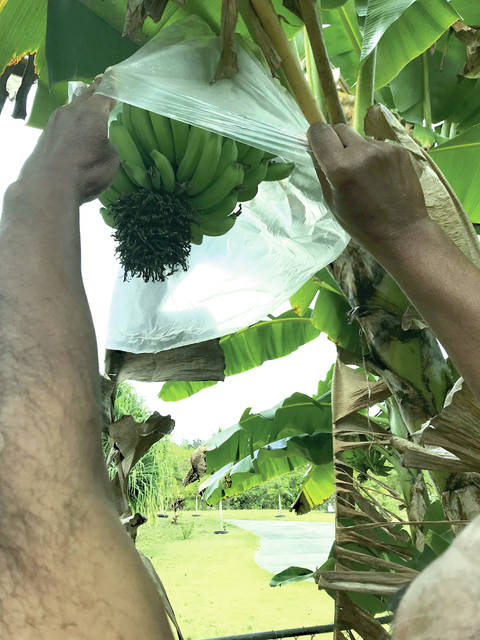Tropical Gardening: Yes, we have no bananas
Farming for a living is tough.
It is enough to drive you bananas, especially if you are a commercial banana grower in Hawaii.
ADVERTISING
Our islands are ideally suited for producing good banana crops, but diseases such as Panama wilt and bunchy top virus make it a real gamble.
Also, during this cool and windy time of year local banana production is low, so we are getting fruit from Central America that is not as delicious.
Since you might be suffering from local banana withdrawal, it might be a good idea to grow your own.
The four secrets to success with bananas begin with the soil.
Banana plants thrive best on good soils fairly rich in organic material. Plants prefer moist situations, provided the soil is well-drained. They will grow in nearly any soil except one composed almost wholly of sand or rock.
Bananas are seriously damaged by salt water and by high chloride accumulation in soils from intrusion of brackish water in coastal areas.
The second secret is wind.
The leaves are likely to be damaged by strong winds; therefore, plants should not be planted in an exposed location. Tattered leaves cannot function as well as undamaged leaves.
Third is that varieties are important.
There are more than 1,000 varieties worldwide and more than 100 can be found here. Identification is not easy unless you really study.
The best way to know your varieties is to obtain them from a reliable nursery. If you get keiki from a neighbor, make sure they are free of disease.
The dwarf varieties such as the Cavendish or Chinese are better adapted to small garden conditions as they have a short, stout stem from 4-7 feet tall, with broad leaves borne on short pedicles. They are somewhat hardier and more wind resistant than taller varieties. The fruit is of medium size, thin skinned and of good quality.
Growing larger to 20 feet, the Brazilian banana types are hardy and prolific
“Williams Hybrid” is larger fruited than the other two and yet not as tall as the apple variety. It is superior for home gardens and is grown commercially.
Other lesser-known varieties with potential are Cuban Red, Dwarf Jamaican and the Thousand Finger of Indonesia.
A good resource book for identifying varieties is “The World of Bananas in Hawaii” by Angela Kay Kepler and Francis G. Rust. The book covers just about everything you ever wanted to know when it comes to this delicious and nutritious fruit.
The fourth secret to your banana success is fertilization.
Banana plants are heavy feeders and respond well to fertilization. Most Hawaii soils are deficient in the major elements — nitrogen, phosphorus and potassium — and might be deficient in the elements of magnesium, calcium, copper, manganese, boron and zinc.
Bananas require all of them.
As a general rule, bananas will thrive on fertilizer mixtures shown by experience to be necessary on other crops grown on each particular soil type. The amounts required also will vary with the various soil types.
Since the bananas are heavy and constant feeders, results usually will be better from frequent light applications than from infrequent heavy applications. Mulches, compost and manures greatly benefit the plants, as well.
While the plants are young it is best to remove all suckers but one. This will force strength into the flowering stalk and leave one to take its place after fruiting. This way, larger bunches of fruit can be expected.
Later, when the mat has matured, three to five stalks can be allowed to grow if well spaced.
Bananas harvested 7-14 days before ripening and hung in a shady, cool place will develop their flavor and nutritive value better than if allowed to ripen on the plant.
Bananas are hardy as far as pests are concerned. Occasional sprays of fungicides might be needed to keep leaves and fruit free of streaking or spotting fungus organisms.
Be sure to read and follow manufacturers directions on the label.
The main disease problem to avoid besides bunchy top is Panama wilt. Bluefield banana is susceptible as are several Hawaii varieties.
If the disease is present, plant resistant varieties such as Williams and Cavendish, since there is no economic cure for the disease.
This information is supplied by the University of Hawaii College of Tropical Agriculture and Human Resources. For more information, contact the Master Gardener Helpline at 322-4893 in Kona or 981-5199 in Hilo.


